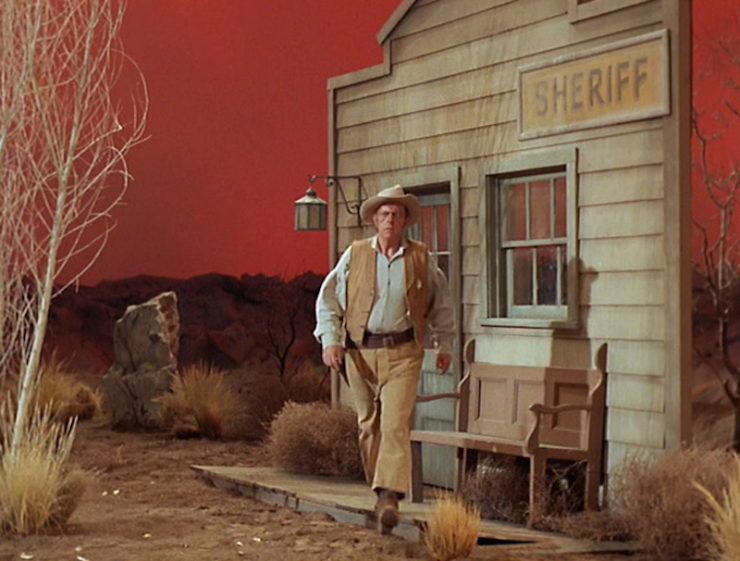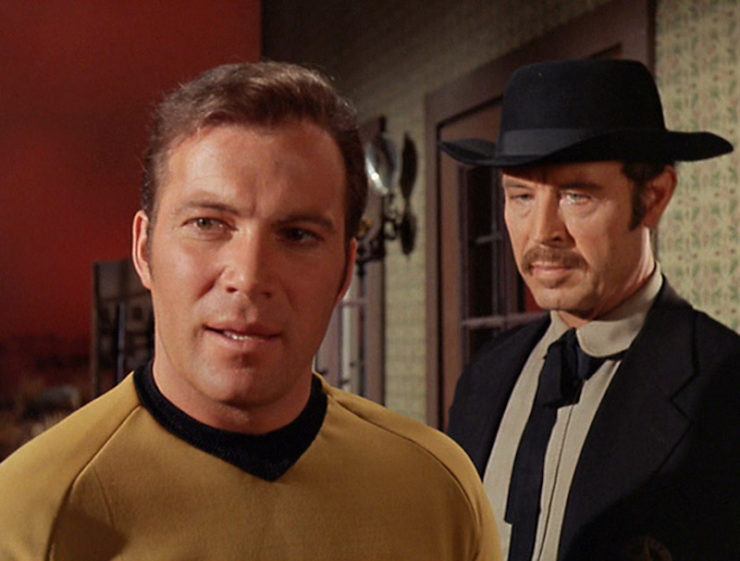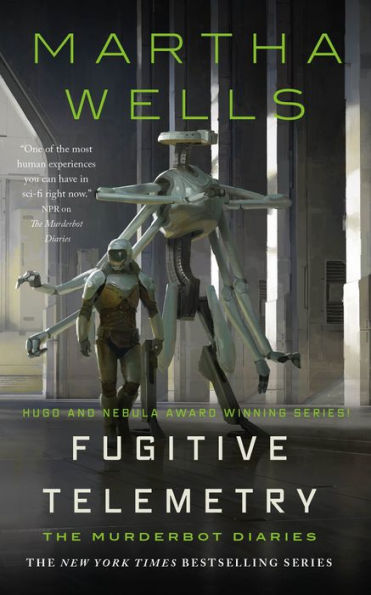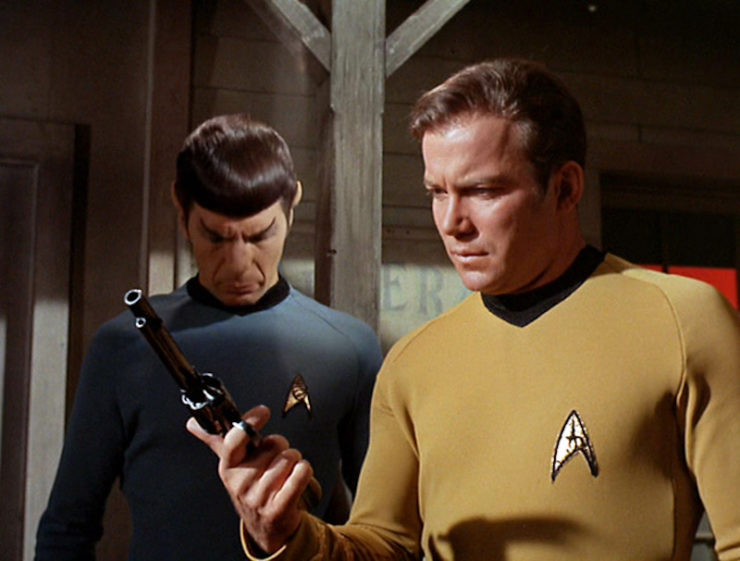“Space: the final frontier.” The opening words of the original Star Trek series intro handily sums up the logic of the space western genre. The Wild West is no longer wild, and has not been for some time. But space is unexplored, untamed, and not fully under the control of a central government, and/or federation. Exchange six-guns for lasers, a horse for a starship, and cattle rustlers for Klingons, and you’re ready to send those old adventure tropes off to the galactic rodeo.
In the original series, Captain Kirk swaggers like a border sheriff through many a lawless outpost. But the episode that most directly shoots at Star Trek’s Western roots is Season Three’s “The Spectre of the Gun,” aired in 1968. Faced with old timey gun fighters, the crew of the Enterprise both lean into the Western genre and try to escape from it—with mixed success. Even at warp speed, it turns out, it’s hard to outride the horse you’re sitting on.
“The Spectre of the Gun” starts as the Enterprise encounters a warning, delivered by telepathic buoy, from a reclusive species known as the Melkotians. The Melkotians tell the ship to stay away, but Kirk has strict orders from the Federation to beam down onto the planet. Once on the surface, the landing party discovers that their phasers and communicators are disabled. After being berated by a giant green Melkotian head, they are transported to Tombstone, Arizona, on the day of the shootout at the O.K. Corral. Kirk, Spock, McCoy, Chekov, and Scott find themselves mistaken for the infamous Clanton gang, destined to be killed at 5:00 by the Earp brothers and Doc Holliday.
The episode is fascinated, as Spock might say, with the historical specificity of the Earp/Clanton battle. It makes sure to repeated reference the actual date of the fight (October 26, 1881) and much is made of the fact that Billy Claiborne (Chekov, here) escaped the showdown unharmed.
Moreover, the aliens tell Kirk that they have chosen this particular doom for him specifically because of who he is. Kirk notes that his ancestors were involved in U.S. westward expansion. Being shot down by the Earps is a kind of karmic retribution for the violence of the captain’s own heritage—the historical truth is also an ongoing spiritual truth and burden. The gunfight at the O.K. Corral is something that happened in the past, but also something that has continued resonance—not least because Kirk is still ignoring boundaries along the frontier just as his forefathers did. Ike Clanton was shot for ignoring brands and stealing cattle; Kirk is similarly going to be shot for ignoring warning buoys and landing where he wasn’t wanted. The Western genre has its revenge on science fiction, here, because science fiction in many ways is still the Western.
“Spectre of the Gun” insists on the Western’s truth and relevance. But at the same time it also is at pains to show that the Western isn’t real.

The Enterprise crew is transported, not to a historically accurate representation of Tombstone, but to a weird, half-formed town that looks like it has dropped in from some eerie Hollywood sound stage. The sky is an angry red, and many buildings are little more than facades with nothing behind them. The town is sparsely populated; there’s hardly anyone there but the Earps, a voluble sheriff, and Sylvia (Bonnie Beecher), a woman in love with Billy Claiborne/Chekov, much to Chekov’s delighted surprise.
The Earps themselves are a menacing presence, but one that deliberately lacks verisimilitude: Actors Ron Soble, Rex Holman, Sam Gilman, and Charles Maxwell as the evil antagonists barely twitch their mustache muscles, and speak in a half whispered monotone. They’re a morose, robotic dream of Western badmen, wandering between cardboard tumbleweeds beneath a red-painted sky.
Eventually Spock figures out the fairly obvious; the crew hasn’t been teleported back in time at all. They’re in a psychic representation, or film version, of the O.K. Corral battle, rather than actually fighting the battle itself. They can’t beat the Erps in a fair fight, but they don’t have to. All they need to do is to stop believing—in the simulation, and by extension the genre—and it will cease to have power over them. Spock mind-melds with each of his companions (except Chekov, who has died temporarily) to make sure they do not harbor a single doubt that the O.K. Corral is not real.
Thus fortified, the crew faces a hail of bullets imperturbably, letting the barrage simply fly through them to cut up the fencing behind. Kirk then beats the tar out of Wyatt Earp hand to hand, and refuses to shoot him. The Melkotians are so impressed with this restraint (“Captain Kirk, you did not kill. Is this the way of your kind?”) that they transport the crew back to the Enterprise, and agree to open peaceful relations.
In a brief conversation before the final credits, Spock asks Kirk why he didn’t kill Earp, even though he wanted to. Kirk responds, with characteristic Shatnerian self-satisfaction, that humans have overcome their violent impulses.

Those violent impulses, here, are specifically figured as the Western genre itself. By refusing to believe in the reality of six-guns and shoot-outs, the Enterprise crew has freed itself from its violent, lawless past. Science fiction looks like the Western in some ways, the episode insists, but the future can rewrite history through sheer force of will, simply by convincing itself that that past is not real, or no longer applies.
It’s appealing to think that we can end violence, or the violent impulses in human nature, by slightly rejiggering our genre investments. But despite its stated faith in this message, there are aspects of the episode that suggest that Kirk’s smug certainty is a little premature…
Buy the Book


Fugitive Telemetry
Kirk doesn’t, after all, behave that differently from the white people who pushed across the United States stealing native land, many of whom also claimed their intentions were peaceful. The Melkotians ask the Federation to leave them alone; they specifically state that they associate Federation contact with disease and contagion. If we’re talking about American indigenous history, this is a pretty reasonable concern. European diseases devastated native populations in the Americas; by some estimates, smallpox and other diseases may have killed 80% of the indigenous population. The Enterprise crew knows the names of obscure white criminals on the American frontier, but seems entirely ignorant of one of the most sweeping demographic catastrophes in global history—a demographic catastrophe that is, moreover, extremely relevant to an exploratory force purportedly intent on doing no harm.
This ignorance of indigenous history is matched by the erasure of native people in the episode’s dream version of Tombstone. The fake town is populated by only white people. The one gesture towards racial difference is Spock, the alien Vulcan. As usual in Star Trek scripts, McCoy indulges in unprofessional xenophobia; he attacks Spock for being too logical and refusing to grieve for Chekov in the correct, human-approved way. The racist animosity towards Spock rather undermines the Federation’s contention that humans have left their hatreds behind them. If I were a Malkotian and witnessed how the crew treats Spock, I would be pretty nervous about making contact too. In the context of a faux genre Western town stripped of racial difference, this brief, intense, motiveless burst of racism directed at Spock is especially uncomfortable. It’s as if the episode has repressed the core, colonialist violence at the center of the Western genre only to have it break out, unexpectedly, in a burst of workplace harassment.
Kirk’s violent ancestors engaged in violence and shoot-outs at places like the O.K. Corral. He must, we are told, deny this aspect of the past, and refuse to believe in its continued relevance in order to spread peace across the galaxy. But refusing to believe in the past is not, in fact, a great way to avoid repeating it. Star Trek flies away from the Western into the future, only to find itself back at the O.K. Corral. The Federation says it comes in peace, but the Malkotians are right to be wary, still seeing the spectre of the gun in those proffered hands.
Noah Berlatsky is the author of Wonder Woman: Bondage and Feminism in the Marston/Peter Comics (Rutgers University Press).











Good article. Some comments:
From Wikipedia:
Ah the good old days.
I find it amazing that Kirk would know much of anything about something that happened 385 years or so before Kirk’s present day. What do I know about 1635? A few factoids (mostly about the deterioration political situation in England in the run-up to the civil wars of the 1640s) and nothing much else.
#1
I believe it had already been established at this point that Kirk was a history buff. Anyhow, later in the movies we do see a lot of antiques in his home, including firearms, so it’s a character trait that carries on.
Many of the newer ‘Weird West’ stories question manifest destiny. I love Arianne ‘Tex’ Thompson’s Children of the Drought series.
That was a quirky episode. Original Trek always struggled with the fact that humanity evolving to a more enlightened state would eliminate many of the tensions that make for compelling drama. Our flaws, unfortunately, are far more interesting than our strengths, at least to the unevolved members of current audiences.
TOS was so much a “space western” that in the first episodes of the first season the away missions wore futuristic “gun belts” to hold their phasers.
Well, Roddenberry did pitch ST to the networks as a “Wagon Train to the Stars”…
Compare “Specter of the Gun” to “Living in Harmony”, the Western-themed episode of The Prisoner, aired a year earlier. As with Kirk & Co., the Prisoner (Number Six) tries to resist his violent impulses and training, despite the constant poking and prodding of his antagonist, the Judge (Number Two).
@6/El Rob Hubbard: “Well, Roddenberry did pitch ST to the networks as a “Wagon Train to the Stars”…”
No, he pitched it as “Wagon Train to the stars.” Wagon Train was a long-running, critically acclaimed adult Western known for its semi-anthology format centering on guest stars of the week. Roddenberry wasn’t pitching “Western in space” with that line — people today forget that something like half the shows on TV at the time were Westerns, so that would’ve been trivial. He chose that particular Western because of what else it was — adult-oriented, intelligent, anthology-like (which was considered classy at the time), highly successful with critics and viewers alike. He was telling network suits that he wanted to do a show in the same vein. At the time, science fiction was stereotyped as cheesy kid stuff, and he compared his show to an acclaimed, successful adult drama to show that he wanted to aim for the same level of sophistication and prestige, and to suggest that his show would be a surefire, long-running hit.
It’s the same elevator-pitch shorthand that’s still used today — “It’s CSI in Ancient Rome!” “It’s Game of Thrones with doctors!” “It’s The Office with robot mice!” Pick some ultra-successful, household-name show and say “It’s like that, but with this twist.” But audiences today have forgotten about Wagon Train and how big it was in its day, so they don’t hear the italics.
@1 – Well, to be fair, it’s much easier to know history when it’s so well documented. 300 years from now, barring some type of apocalypse, people should (or can) be very familiar with this time, as everything is so well documented. You have the internet, pictures, videos, articles, etc. 300 years ago for us is unfathomable because of the lack of documentation.
One thing that’s largely lost to us today, but would have been very strange to audiences at the time is the presentation of the Earps as bad guys. Wyatt retired to Los Angeles and quite a bit of money selling his version of the story to Hollywood, and that was the only version people had known for over 50 years. It would still be several years before the entertainment media began to question the veracity of Wyatt’s version of the story along with a lot of other aspects of the “Wild West”.
It’s unclear how much of “Spectre of the Gun” was “real”, strictly none, it’s a TV show. I may be remembering from James Blish that Enterprise had orders to make contact regardless – his points usually are in the script but not necessarily still there at show time. But Kirk warned off and pressing on could be a hallucination too, and forced by the Melkotians. Only the away team experienced going close to the planet. They got Q’d. Another interpretation is that there has been trouble with the planet already that needs to be dealt with, even if the deal reached is “Make anyone who comes here forget why, and notify the Star Chamber”.
The main story is that James Kirk is way too into cowboy history, which at the time might surprise viewers.
@11/Robert Carnegie: “The main story is that James Kirk is way too into cowboy history, which at the time might surprise viewers.”
I doubt it. At the time, Westerns were as ubiquitous in popular entertainment as superheroes are today. As DemetriosX said, everyone was intimately familiar with the story of the Earps and the OK Corral from all the movies that had been made about them (at least one of which had featured DeForest Kelley). So nobody watching this episode in 1968 would’ve found it surprising that an American starship captain in the future would’ve known as much about it as they did.
For me, the flaw of the episode is that Spock is an expert on Tombstone history, lecturing Kirk and McCoy on their own national history. It would’ve been a nice change of pace if Spock had been the one who needed McCoy to explain it all to him.
What is it with the Federation on the one hand claims that their Prime Directive says that they cannot interfere and yet, on the other hand, on more than one occasion tells Kirk to ignore any requests to be left alone and orders him to make contact.
I half expect to see Starfleet officers wandering around my neighbourhood, ringing doorbells and asking if people believe in the Prime Directive. Even if there’s a sign saying No Solicitors.
Maybe Kirk spent the time after “Shore Leave” ended playing Westworld with android badmen and wouldn’t shut up about it after.
What I meant is that a 1960s U.S. WASP audience would find “loves cowboys too much” an unfamiliar concept, along with “a civil war of race = bad” and “the Constitution is even for people who are ethnically Communist” and “a surprising number of extraterrestrial cultures have women in senior roles”.
@14/Robert Carnegie: “What I meant is that a 1960s U.S. WASP audience would find “loves cowboys too much” an unfamiliar concept”
If you mean that Western-loving ’60s audiences wouldn’t have thought it was possible to be too fond of Westerns, I take your point, but I don’t see how that applies here. Yes, the Melkots chose a manner of execution derived from Kirk’s heritage, and that happened to be a Western scenario, but he and the crew weren’t sentenced to death because he knew Tombstone history. That only determined the method.
Meanwhile, there were plenty of ’60s Americans, even among WASPS, who would have agreed with “a civil war of race = bad” and “the Constitution is even for people who are ethnically Communist” (did you mean “ethically?”). After all, pretty much all of Star Trek‘s writers were WASPs, or at least white.
#10
The questioning of the Earp legend had already started the year before in 1967’s Hour of the Gun, where James Garner played Wyatt with far more of an edge than had been previously shown. Gone was the smiling clean-cut hero played by Burt Lancaster. Now he was a mustached, black-hatted hardcase, much like the one seen in Spectre. Still the protagonist in that film but less of a pure hero.
The Searchers came out in the late 50’s and it was a “revisionist “ western. IMHO it was John Wayne’s best acted film. So the concept of “loves cowboys too much” was certainly in the air
Looking back, it’s perhaps ironic. After all, as Stinky Pete said about the death of the western, “Two words: Sput Nik. Once the astronauts went up, kids just wanted to play with space toys.”
I don’t think Kirk denies the past, he tries to show that humanity has moved beyond it by refusing to fight. Also note how the Earps, usually the heroes, are shown as the bad guys.
I’ve always thought that “Spectre of the Gun” was an anti-Western. After all, the heroes spend the entire episode trying to avoid the gunfight. Like many Gene Coon episodes (“Arena”, “Errand of Mercy”), it’s a rejection of violence. It’s especially ingenious because it uses Western props to tell an anti-Western story.
As for “The fake town is populated by only white people”, almost every planet they encounter is populated by only white people. This is certainly objectionable, but in no way specific to this episode.
They thought we needed to see “Let That Be Your Last Battlefield”.
Another time, far as I remember, it is shown that Kirk is put on “Court Martial” with a Black guy in charge and an ex girlfriend prosecuting, almost none of which is mentioned (ex girlfriend goes without saying? but doesn’t)
@9:
True, people could know more about what happened in the distant past. But most people in the real world don’t care about history- they learn what they have to to pass history tests in school, and go no farther. Yet the crew of the various Star Trek shows are all familiar with 20th century history.
From a Doylist perspective, this makes sense – you should avoid the “as you know, Bob” as characters explain to each other what the audience already knows. So people 350 years from now have to be familiar with the 20th (and now 21st) century to make the plot go. But Watsonially I’d guess they’d have to check SpaceWikipedia for what to them would be historical minutiae before proceeding.
For instance: I’m a Canadian and what I know about what was going on in what is now Canada in the 1630s is pretty limited. Was Samuel de Champlain still alive? What tribes were where? Had the English taken any bits of the Maritimes yet, or were they just in part of Newfoundland? How big were the settlements that would become Montréal, Quebec City, or Halifax? Who lived there? Only native peoples? How prevalent were European traders, if at all? No idea. I’d have to check Wikipedia to get an overview. I suspect it would be the same for 23rd century people and their knowledge of the 20th-21st centuries.
i hated that episode of star trek, it also started my detest of space westerns, yet surprisingly i liked firefly and avatar. it also made me turn up a lot of American style fiction, mostly because it was based on western style of plot or the hollywood version of blood and guts all American hero. in some respects it limited the availability of good reads, but it also lead me to discover fabulous science fiction written in other countries translated to english. i like a number of British authours, Russian, Indian, German, Spanish, etc. i would argue any of them are better than space westerns.
I am surprised that no one has mentioned Deforest Kelley’s role as Morgan Earp in “Gunfight at the Ok Corral” (the Burt Lancaster/ Kirk Douglas one). So Dr McCoy did have first-hand knowledge of the event in a roundabout way.
@24/James: I alluded to it in comment #12, though I didn’t remember what movie it was or what Kelley’s role was.
Pedant Powers — Activate!
I have read that the minimalist set was a result of the budget — they’d originally wanted a standard Western set, but that was what they could afford. No idea if it’s true, but a lot of the show was haunted by budget problems. Though I can’t understand why there was nothing in the back lot to adapt…
@26/Liddle-Oldman: The third season had to cut its budget a lot to stay on the air, as is often the case with shows struggling in the ratings. So it featured more minimalist sets and had hardly any location work, as well as having fewer guest stars and extras — which was why the landing parties were so often just the main cast and no security or yeomen, and why the ship often seemed so much emptier than it had been in earlier seasons. (Much the same happened with Batman — its third-season sets tended to be stagey and impressionistic much like the Western set here, but without the excuse of being an illusion.)
The original intention was to shoot on a standing backlot location, but I guess even that was deemed too costly. I’m not sure why, though, because there was a Western town backlot right there on the Paramount lot at the time, as seen here. But maybe it was booked up by other productions?
Re history, I think the crew can tell you about the Eugenics Wars of the 1990s, although no one recognises Khan. …reminds me I STILL have not had a haircut since SARS-COV-2 arrived.
I think they may spend more time having briefings on historical periods that the audience doesn’t recognise. Roman Empire, Nazis, Native American Brigadoon, not a problem. Greek gods and such I think did take more work.
I think the surreal western town was very effective. If you tuned in and didn’t see the main characters, you wouldn’t mistake it for a standard western. After all, Gunsmoke and Bonanza had walls.
@27: “The original intention was to shoot on a standing backlot location, but I guess even that was deemed too costly. I’m not sure why, though, because there was a Western town backlot right there on the Paramount lot at the time, as seen here. But maybe it was booked up by other productions?”
Filming outdoors is always more expensive than filming on a soundstage. Lighting takes longer, has to be done several times during the day as the sun moves, and you have to be more careful with boom mikes because of all the outdoor sounds, etc. Their budget didn’t extend to filming this episode outdoors, even with the existing western backlots. So, they had to build a western town on a soundstage… and they didn’t have the budget to do that to completion either. So, they went with a surreal set.
@30/Michael: Makes sense. I was just thinking of the other side of the equation, that the backlot Western street was already built. So it’s a question of whether the expense of outdoor shooting on a standing set outweighs the expense of building a new, minimalist set on a soundstage. I guess it did.
@24–Unreliable Rumor Hath It that the episode was actually written specifically for DeForest Kelley, since he was in a large number of Westerns besides the one mention (we watch a channel where there are a lot of them, and we see Kelley fairly often).
@32/excessivelyperky: I think it’s far more likely that, like “A Piece of the Action,” the episode was written with an eye toward saving money by finding a way to reuse the studio’s stock historical sets, costumes, props, etc. in a science fiction context. If anything, it’s surprising it took them this long to do a space-Western episode, although they had previously made use of locations often used in Westerns (e.g. the cliffs and fort at Vasquez Rocks as seen in “Arena” or the historic-town backlot block seen in “The Return of the Archons”).